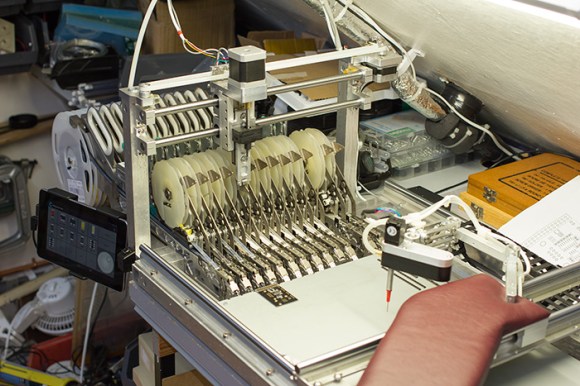
This is a fascinating take on building your own pick and place machine. It does an amazing job of automating the hardest parts of hand assembly, while relying on human dexterity to achieve the hardest parts of automation. It’s a semiautomatic pick and place machine driven by an Arduino and controlled by an Android tablet.
The machine is built in two parts. The portion in the upper left feeds components from reels and is fully automated. The portion on the lower right consists of a padded arm-rest which slides smoothly along two axes. A mechanical arm with multiple articulations is attached to the end, culminating in a tip connector for some vacuum tweezers. Right handers are the only ones who will find this convenient, but oh well. The clip after the break shows it in action. The assembly technician first selects the component from an icon on the Android tablet. The reel machine then dispenses that part, which is picked up by the vacuum tweezers using the left hand to switch the vacuum on and off again. If the part orientation needs to be rotated it can done using the jog wheel on the Android app. It smooth, quick, and best of all, clever!















Mayhaps You meant:
“http://www.youtube.com/embed/vkPkjBfZXDg”
I’ve never really done any SMD stuff so I ask out of genuine curiosity, is this really so much easier than just using conventional tweezers? Or indeed than building a fully automated pick and place machine?
This was the first stage of making a fully automated system. After looking at a lot of the DIY pick and place projects online, i found that most used a very basic feeder system which required a lot of manual work to move the component strips and clean the header tape away so I started the project from the feeders first and then plan to automate the other axis’s later.
Do you intend to implement Camera support (external USB or internal one after gutting it out of the tabled on extension cord) inside Android app?
I have been trying to find a way to have video input on android but there dosnt seem to be any drivers available to use with an OTG cable and camera at the moment
http://brain.cc.kogakuin.ac.jp/research/usb-e.html
um, forgot to check “Notify me of follow-up comments via email”
Thank you for the link, I will see if i can get this working on the tablet
I look forward to seeing the finished piece. It’s still a pretty cool device as it stands, and I think someone below has given me the reason for the need for vacuum tweezers. All good to know.
You definitely want to use some sort of vacuum tweezers for QFN or BGA packages. It’s nigh impossible to align dozens of pins at a 0.5mm pitch at the shaky tips of your fingers. I learned the hard way myself – after ruining some quite pricy chips I hacked myself a solution from a 3D printed parts, an air mattress pump and screws for XYZ translation. It really made all the difference.
Ok i love HAD I really do but u guys need to proof read before posting. Its probably on 2 axis not axes i’ve never heard of a let hand so i assume u meant left. Sorry interesting article but its not just this one that has typos its most of them ever since the last redbull contest.
Thumbs up.
WOAH, know your axes before you comment!
You are correct. There is one axis:
“We shall draw this line and call it the x axis.
If there is more than one axis, it is axes.
“The stress analysis was done on the x-y-z axes.
_However_, if you are using it as an adjective, then it would still be axis. For example:
A three-axis milling machine.
Incidentally, I hope thevac was being ironic with his typos and lack of punctuation in his comment!
On a phone i know about my typos
Sorry for the DP but im also not writing an article that the educated minority reads i could understand if this was a thread on a forum or something but its not and takes like 2 minutes to proofread these bite sized bits of supa l337 haxzor genius
You must belong to axes of evil!
Thanks for sharing your knowledge of the English language. Even better in the future you could be a little less scolding in you tone.
When you’re going to criticise spelling and grammar, you should probably make sure you get your own (not to mention capitalisation) correct first.
Anyone who uses text shortcuts like “u guys”, along with shoddy grammar, and does not know singular from plural may want to avoid commenting on grammar, spelling, and, writing style. Phone or not, “thevac”. What does this mean: “Ok i love HAD I really do but u guys need to proof read…” FAIL.
I had originally hoped he was just being ironic/sarcastic, but it looks like isn’t after all….
Pot, meet Kettle. Kettle, meet Pot. I assume you both have a lot in common.
Enough speling one-upmanship already.
Great job guys. You must have way better eyesight than me. I’d have to have my beak right in there where the tweezer tip is! And with magnifier headband on, too.
Sloppy English aside, this is a well built project. To Mental2k, assembling SMT boards from tape reels rolling around on your desk, or small bits of tape, with tweezers is indeed tedious. I’d love to have a machine like this
This is a really interesting compromise between a full P&P and manual placement And the build quality looks terrific.
At work we’ve been pondering the possibility of getting a second hand P&P machine but the cost seems prohibitive, I think we might look into a semi-automatic one like this.
Congratulations on an excellent project.
cool stuff.!